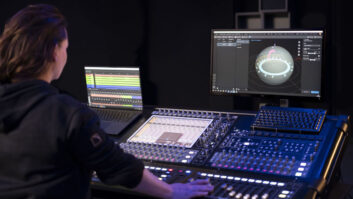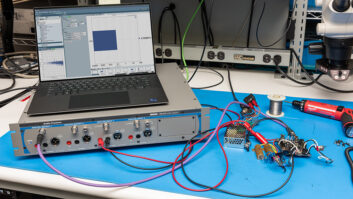Founded in 1994, Spectral Design has been quietly-or perhaps not so quietly-making a name for itself as one of the world’s major developers of signal processing software. And even if the Spectral Design name doesn’t immediately register with most members of the North American pro audio community, chances are that without realizing it, a sizeable percentage of audio engineers in this hemisphere have encountered Spectral Design products in one form or another.
The company is jointly owned by Houpert Digital Audio (HDA) and Steinberg (yes, the Cubase and VST people), and although this Bremen, Germany-based firm has a similar name to the American company Spectral Synthesis, there is no connection between the two. Spectral Design creates the digital signal-processing effect plug-ins for Steinberg’s Cubase VST software, and uses Steinberg’s WaveLab for the AudioCube[superscript]3-II’s basic editing functions. Anyone who’s used Sound Performance Lab’s (SPL) acclaimed Red Series of hardware processors-such as Machine Head, Loudness Maximizer or the Spectralizer-has also gotten a taste of the DSP that Spectral Design has to offer.
And now, after a year of European installations, Spectral Design’s line of turnkey mastering workstations-AudioCube[superscript]3-II, Quadriga and SurroundCube-is finally available in the U.S. and Canada.
BUILT FOR SPEEDNow in its second generation, AudioCube[superscript]3-II is a single-system solution combining professional audio processing with leading-edge technology. At the core of the system is a beefy, 55-pound, five-rackspace enclosure containing two 500MHz Pentium III CPUs. The system is built and designed to provide optimal performance from the ground up. There are no dedicated audio cards, as found in other systems. Here the Spectral Design philosophy is simple: Essentially by the time DSP cards are developed and brought to market, they tend to be obsolete. And as non-card systems based on a single CPU can overwhelm the central processor, the alternative for fast, real-time audio processing turned out to be dual 128MB/500MHz Pentium IIIs running in tandem under native NT. Internal processing is 32/64-bit floating point with 24-bit/96kHz support. Retail is $25,950, including hardware, a waveform editor and a complement of signal processing plug-in instruments.
A 20-bit/96kHz D/A is provided for analog monitoring, but there is no analog I/O. (Probably a good move because anyone purchasing a system such as this very likely has favorite converters already picked out!) Digital I/O possibilities include AES/EBU, S/PDIF (co-ax and Toslink) and word clock; ADAT Lightpipe is optional. The system also includes a removeable 9GB hard drive, an 8x write/20x read CD-R, 40x CD-ROM, 100Mbit Ethernet card, external UltraWide SCSI card, and a dual monitor card. Hardware options include a remote control kit and Exabyte 8mm tape streamer for DDP and backup.
AudioCube[superscript]3-II is networkable (ATM, FDDI or Ethernet), so it could operate as a server or reside on the same server as other workstations, allowing fast transfers between, say, AudioCube[superscript]3-II for cleaning up tracks and other DAWs (Mac or PC) doing simultaneous dialog editing. And as the system can directly load .WAV or AIFF files, there is no need for conversion when tracks are transferred to/from AudioCube[superscript]3-II from either Mac- or PC-based DAWs.
The system uses WaveLab 3.0 as its waveform editor of choice, offering real-time processing; edit lists; multichannel arrangements; clip-based editing; non-destructive crossfades; normalization; timestretch; sample rate conversion; CD mastering; and PQ editing. However, the real “heart” of AudioCube[superscript]3-II is its Master Section, a control screen where access to any of its tools is a mouse click away. But beyond a simple control screen, the Master Section allows selecting any six of its VPI (Virtual Precision Instrument) plug-ins in series and in any order desired, with a bypass button for each, followed by selectable dithering and master faders.
SOFTWARE, SOFTWARE, SOFTWARE…System VPIs include DeNoiser, DeClicker, Loudness Maximizer, Spectralizer (digital enhancer), EQ1 (Parametric Equalizer) and ReSampler (sample rate converter). Other VPIs-available at $1,750 each-include DeScratcher, DeCrackler, DeClipper, DeBuZZ, DeMotorizer, Magneto (tape emulation), FreeFilter, RepairFilter, DoubleRate (44.1 to 88.2 and 48 to 96 kHz and vice-versa), AnalogEQ (multiband parametric EQ with up to 192kHz processing), FreeShaper (for creating custom noise shaping/dithering curves), Azimuth (tape azimuth error corrector) and De-Es (de-esser).
Clearly the aspect that sets AudioCube[superscript]3-II apart from simply running these or similar plug-ins on an existing workstation is the absolute speed of the DSP, thanks to the native NT processing and the dual CPUs. Most of the VPIs run in real time, and interestingly, up to six of them can run automatically, making “intelligent” decisions about parameters, before you begin tweaking. For example, as the input material plays through the DeCrackler, the system searches downward, seeking a workable threshold where a majority of a record’s surface noise is removed without destroying the character of the original recording. Once the program reaches that point, of course, the user is free to tweak at will. Using the DeNoiser, the input material is continually analyzing as it plays, offering dynamic-rather than static-processing. This provides as much as 20 dB of noise removal, without removing early reflections or room ambience, which can be construed as noise in other programs. Another nice touch in most of the restoration modules is an onscreen “audition” switch that switches the playback to let the user listen to that portion of the sound that’s being removed, as a way of ensuring that processing isn’t set too high or too low.
A key to the AudioCube[superscript]3-II VPIs is that there are many applications available, focused on highly specific problems, and they are extremely easy to use-a user can become an expert on any of these VPIs in a matter of minutes. However, these are anything but lightweight or stripped-down applications. As in most cases, the simple interface hides a great deal of the complexity, while the power is still there.
On a VPI such as the RepairFilter-a dynamic notch filter with four notch filters, plus HP and LP filters-problem frequencies show up onscreen as straight “disturbance” lines on a spectrum display to pinpoint what you need to notch. Notches can be set automatically or manually (user choice), but what impressed me was the fact that the notch depth is program-dependent, depending on the amount of inherent masking present in the audio source material.
Designed for hum reduction, the DeBuZZ VPI shows a problem as fundamental as a peak and highlights all of its harmonics for removing AC hum or dimmer buzz. Intended specifically for eliminating camera and zoom motor noise picked up from on-camera mics on video tracks, the DeMotorizer takes a small section of drive and zoom motor sections, “learns” the sound of the noise, and applies as much as 90 dB of attenuation.
Another VPI that takes full advantage of continuously changing dynamic processing is Azimuth, which corrects for phase and time shifting cancellations that occur from a tape head that’s out of azimuth. Here, the software automatically corrects the errors as the audio plays, with time correction as fine as 11/4100-sample increments. With autotracking, Azimuth can follow a “floating azimuth” error, which would not be possible with a screwdriver on the tape machine, because the error changes over time.
FreeFilter is a third-octave graphic EQ with frequencies set at standard ISO points, but it is a linear phase design, and unlike a graphic EQ-which creates a series of boost “bumps”-it outputs smooth curves. A unique “learn” section calculates difference curves between two files and can superimpose the tonal spectrum from one file over another file. This is especially useful in cases such as compilation CDs, in which the goal is achieving continuity between files.
Perhaps one of the most useful VPIs is DeClipper, which can take a clipped waveform (up to 100 samples in length) and, after lowering the gain of the overall file, can restore the missing peaks. The program automatically searches for the largest clips in a file, displays their duration and calculates how high (in dB) the peaks would have been. Depending on the file, the results are quite good-certainly miles ahead of a severely clipped playback-and just to prove it to the user, a level change is applied to both the original and processed files for easy A/B comparisons.
Beyond the wealth of available VPIs, other options for AudioCube[superscript]3-II include CD-Inspector, a hardware/software system based around a Sony CDP-D500 CD player, providing a means for running an absolute check of recorded CD-Rs, for block error rate, burst error rate, non-correctible (E32) errors, non-valid samples and mutes. Test results can be saved and printed-even in CD booklet format-listing all verification, track data, indices, pre-gap, emphasis flags, ISRC codes and UPC/EAN coding. Another “must-have” option is DDP-Solution, a tool for transferring the final master-including all PQ data-to an Exabyte drive, and verifying the data after transfer.
WHAT’S NEXTThe whole point of any modular system is the capacity for expansion and growth. Based on the same AudioCube[superscript]3-II hardware is the Quadriga system (also $25,950, or $5,450 as an upgrade to an existing AudioCube[superscript]3-II system), a specialized version for analog-to-digital transfer of audio archives. Developed with the needs of European broadcasters in mind, Quadriga monitors incoming audio data streams, recognizes errors automatically and captures audio data stored in the EBU Broadcast Wave file Format (BWF) together with all related meta data and error reports.
Appealing to a large market hungry for multichannel mastering tools, Spectral Design has announced SurroundCube ($44,450), which combines the ease of WaveLab editing with SurroundMaster software, expanding WaveLab to 8-channel editing capacity and real-time mastering for 5.1 DVD or 7.1 cinema sound, and allowing CD and DVD mastering in the same environment. SurroundCube is based around dual 650MHz Pentium III CPUs, with eight channels of ADAT Lightpipe I/O (24-bit compatible), and an 18GB hard drive. Other standard amenities include a SMPTE interface, the same VPI complement as AudioCube[superscript]3-II, along with MultiComp, PitchBandit, Channel EQ, Dynamics (compressor/limiter/SoftClip/AutoLeveler) as well as 8-channel versions of EQ, Loudness Maximizer, Compression, Dither and Leveler.
Although pricey (since when was a first-class ticket ever considered cheap?), Spectral Design’s $25,950 AudioCube[superscript]3-II is a powerful system that takes the science of mastering to a new level, providing a professional tool set for mastering, archiving and restoration chores. And in an era when it’s increasingly harder to separate the pros from the players, systems such as AudioCube[superscript]3-II may be just the ticket.
Spectral Design, distributed in North America by Sascom Marketing, 34 Nelson St., Oakville, Ontario, Canada l6L 3H6; 905/469-8080; fax 905/469-1129; www.sascom.com or www.spectral-design.com.







